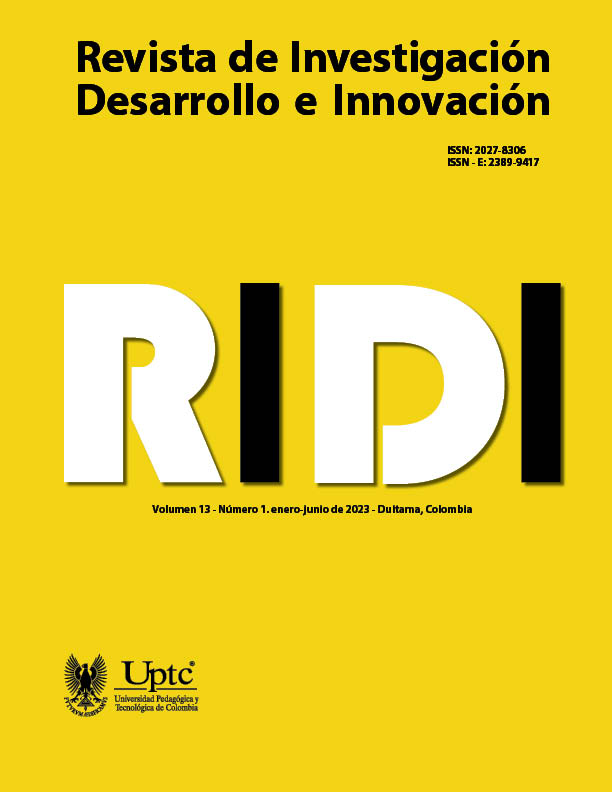Analysis of balanced, unbalanced, sinusoidal and nonsinusoidal three-phase systems through a Python developed tool

Resumen
Este trabajo propone una herramienta en Python para el análisis de sistemas trifásicos equilibrados, desequilibrados, sinusoidales y no sinusoidales basada en la norma IEEE Std. 1459. La herramienta propuesta fue desarrollada para ser utilizada por ingenieros eléctricos y profesionales de carreras afines, proporcionando un acceso libre para el cálculo de la potencia eléctrica que permite validación y análisis de esta en los sistemas de potencia. La herramienta propuesta está disponible para su uso en un enlace de GitHub y solo requiere como entradas las señales de voltaje y corriente, por lo que es posible prescindir de costosos analizadores de redes comerciales. La herramienta está compuesta por dos interfaces, una para realizar cálculos de potencia de sistemas trifásicos sinusoidales y otra para realizar cálculos de sistemas trifásicos no sinusoidales; ambas interfaces son accesibles a través de un menú principal. La herramienta propuesta facilita la toma de decisiones en sistemas eléctricos, lo que ayuda a mejorar la eficiencia y calidad de la energía de estos sistemas.
Palabras clave
calidad de energía;, IEEE Std. 1459;, Python;, sistemas trifásicos no sinusoidales
Biografía del autor/a
León Felipe Serna-Montoya
Ingeniero Electricista, Magíster en Ingeniería
Juan Pablo Suárez-Ramírez
Estudiante de Ingeniería Energética
Manuel Ramírez-Gil
Estudiante de Ingeniería Energética
Nicolás Muñoz-Galeano
Ingeniero Electricista, Doctor en Ingeniería
Juan Bernardo Cano-Quintero
Ingeniero Electrónico, Doctor en Ingeniería
Jesús María López-Lezama
Ingeniero Electricista, Doctor en Ingeniería
Citas
- Alexander, C. K., & Sadiku, M. N. O. (2012). Fundamentals of electric circuits (5th ed.). McGraw Hill Higher Education.
- Artale, G., Caravello, G., Cataliotti, A., Cosentino, V., Cara, D. Di, Guaiana, S., Panzavecchia, N., & Tinè, G. (2021). Measurement of Simplified Single- and Three-Phase Parameters for Harmonic Emission Assessment Based on IEEE 1459-2010. IEEE Transactions on Instrumentation and Measurement, 70, 1–10. https://doi.org/10.1109/TIM.2020.3037949 DOI: https://doi.org/10.1109/TIM.2020.3037949
- Asadi, F., & Eguchi, K. (2020). Fundamental concepts of power electronic circuits, 421–526. https://doi.org/10.1016/B978-0-12-817364-0.00008-4 DOI: https://doi.org/10.1016/B978-0-12-817364-0.00008-4
- Beig, A. R. (2016). 10 - Three-phase AC supply. In M. H. Rashid (Ed.), Electric Renewable Energy Systems, 183–208. Academic Press. https://doi.org/https://doi.org/10.1016/B978-0-12-804448-3.00010-4 DOI: https://doi.org/10.1016/B978-0-12-804448-3.00010-4
- Blasco, P. A., Montoya-Mira, R., Diez, J. M., & Montoya, R. (2020). An Alternate Representation of the Vector of Apparent Power and Unbalanced Power in Three-Phase Electrical Systems. Applied Sciences, 10 (11). https://doi.org/10.3390/app10113756 DOI: https://doi.org/10.3390/app10113756
- Blasco, P. A., Montoya-Mira, R., Diez, J. M., Montoya, R., & Reig, M. J. (2018). Formulation of the Phasors of Apparent Harmonic Power: Application to Non-Sinusoidal Three-Phase Power Systems. Energies, 11 (7). https://doi.org/10.3390/en11071888 DOI: https://doi.org/10.3390/en11071888
- Blasco, P. A., Montoya-Mira, R., Diez, J. M., Montoya, R., & Reig, M. J. (2020). Compensation of Reactive Power and Unbalanced Power in Three-Phase Three-Wire Systems Connected to an Infinite Power Network. Applied Sciences, 10 (1). https://doi.org/10.3390/app10010113 DOI: https://doi.org/10.3390/app10010113
- Emanuel, A. E. (1998). The Buchholz-Goodhue apparent power definition: the practical approach for nonsinusoidal and unbalanced systems. IEEE Transactions on Power Delivery, 13 (2), 344–350. https://doi.org/10.1109/61.660900 DOI: https://doi.org/10.1109/61.660900
- Emanuel, A. E. (1999). Apparent power definitions for three-phase systems. IEEE Transactions on Power Delivery, 14 (3), 767–772. https://doi.org/10.1109/61.772313 DOI: https://doi.org/10.1109/61.772313
- Emanuel, A. E. (2004). Summary of IEEE standard 1459: definitions for the measurement of electric power quantities under sinusoidal, nonsinusoidal, balanced, or unbalanced conditions. IEEE Transactions on Industry Applications, 40 (3), 869–876. https://doi.org/10.1109/TIA.2004.827452 DOI: https://doi.org/10.1109/TIA.2004.827452
- Fortescue, C. L. (1918). Method of symmetrical co-ordinates applied to the solution of polyphase networks. Transactions of the American Institute of Electrical Engineers, 37, 1027–1140. https://doi.org/10.1109/T-AIEE.1918.4765570 DOI: https://doi.org/10.1109/T-AIEE.1918.4765570
- Frank, B. (1992). Die drehstrom-scheinleistung bei ungleichmassiger belastung der drei zweige (Vol. 2). Licht und Kraft.
- Graña-López, M. A., García-Diez, A., Filgueira-Vizoso, A., Chouza-Gestoso, J., & Masdías-Bonome, A. (2019). Study of the Sustainability of Electrical Power Systems: Analysis of the Causes that Generate Reactive Power. Sustainability, 11 (24). https://doi.org/10.3390/su11247202 DOI: https://doi.org/10.3390/su11247202
- IEEE Std. 1459 (2010). IEEE Standard Definitions for the Measurement of Electric Power Quantities Under Sinusoidal, Nonsinusoidal, Balanced, or Unbalanced Conditions - Redline. (2010). IEEE Std 1459-2010, Revision of IEEE Std 1459-2000 - Redline, 1–52. https://doi.org/10.1109/IEEESTD.2010.5953405 DOI: https://doi.org/10.1109/IEEESTD.2010.5953405
- Jopri, M. H., Skamyin, A., Manap, M., Sutikno, T., Shariff, M. R. M., & Belsky, A. (2022). Identification of harmonic source location in power distribution network. International Journal of Power Electronics and Drive Systems (IJPEDS), 13 (2), 938. https://doi.org/10.11591/ijpeds.v13.i2.pp938-949 DOI: https://doi.org/10.11591/ijpeds.v13.i2.pp938-949
- Juansuarezr. (2021). Three-phase-power-calculator. GitHub. https://github.com/juansuarezr/Three-phase-power-calculator
- Kaur, A. P., & Singh, M. (2022). Design and development of a three-phase Net Meter for V2G enabled charging stations of electric vehicles. Sustainable Energy, Grids and Networks, 30, 100598. https://doi.org/https://doi.org/10.1016/j.segan.2021.100598 DOI: https://doi.org/10.1016/j.segan.2021.100598
- Li, J., Fang, H., Liao, C., & Du, J. (2020). A New Method for Determination of Harmonic Responsibility Based on Quality Engineering Theory. IEEE Access, 8, 119071–119081. https://doi.org/10.1109/ACCESS.2020.3001031 DOI: https://doi.org/10.1109/ACCESS.2020.3001031
- Macedo, J. R., Xavier, G. L., Gondin, I. N., Oliveira, L. T. S., & de Oliveira, R. F. B. (2020). An update on the performance of active energy meters under non-sinusoidal conditions. Electrical Engineering, 102 (3), 1785–1794. https://doi.org/10.1007/s00202-020-00991-y DOI: https://doi.org/10.1007/s00202-020-00991-y
- Qi, Y., Fang, J., & Tang, Y. (2020). Utilizing the Dead-Time Effect to Achieve Decentralized Reactive Power Sharing in Islanded AC Microgrids. IEEE Journal of Emerging and Selected Topics in Power Electronics, 8 (3), 2350–2361. https://doi.org/10.1109/JESTPE.2019.2904077 DOI: https://doi.org/10.1109/JESTPE.2019.2904077
- Tleis, N. (2019). Symmetrical components analysis of faulted three-phase networks containing voltage and current sources. In Power Systems Modelling and Fault Analysis. https://doi.org/10.1016/b978-0-12-815117-4.00002-3 DOI: https://doi.org/10.1016/B978-0-12-815117-4.00002-3